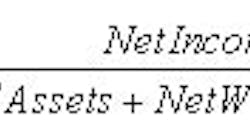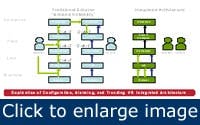In today’s global marketplace, competitive manufacturing and production companies understand that an asset management program is critical to staying ahead and maximizing return on net assets (RONA). The higher the RONA, the better the profit performance is for the company.
While the RONA equation is relatively straightforward, the factors going into the equation are ever-changing. This article outlines the expanding definition of asset management, describes the necessary capabilities of a modern asset management solution and explains how best to implement a solution that features integrated condition monitoring technology.
Asset management redefined
Modern asset management technologies and processes touch almost every aspect of a corporation, including operations, maintenance and finance. Historically, assets managed referred to physical machines. Now, both physical and nonphysical assets are managed, including machinery, spare parts, consumable fuels, raw materials and excess capacity, as well as others.
Almost any company can improve its effectiveness by adding a single dimension to its asset management program: data integration. To ensure maximum uptime of critical equipment, condition monitoring software gathers data from existing control and process systems. Actionable output is then provided to a computerized maintenance management system (CMMS) and/or to operators, maintenance or other appropriate personnel.
Integrating condition monitoring into the program
The first step to adding condition monitoring to an asset management program is to conduct a formal reliability-centered maintenance (RCM) study of existing assets. The objective of an RCM study is to understand and document each asset in the facility with respect to its criticality, function and optimum output. Then, appropriate levels of diagnostic monitoring can be applied to achieve the greatest return on available investment dollars and provide a framework for later expansions.
Once the RCM study is complete, the next step is to select a condition monitoring software solution that provides the necessary capabilities. Not only is fixed asset data capture important, but the condition monitoring software must gather and integrate data from the plant’s control systems and process historians, perform analysis, and communicate vital information to other systems automatically. The system should also offer an intuitive interface, such as a hierarchy tree, that provides simple access to further levels of detailed asset information.
[pullquote]Asset information may include a link to a physical location or piece of external system equipment, allowing the condition monitoring software and other external systems to share component information. This data-sharing enables automatic annunciation of the information to plant personnel and CMMS, creating a closed-loop system. This data integration and backup is a critical addition to an asset management program.
To further enhance value, condition monitoring systems should use open database platforms such as Oracle or Microsoft SQL Server, nonproprietary data formats and data import specifications. These specifications allow the information to be formatted so it can be imported into the condition monitoring software database. It is also important that the condition monitoring software support management and analysis of different types of data for the system to use plantwide data sources. The software should accept numerous data types and allow user-defined units, further enabling system integration.
Most condition monitoring software solutions provide standard vibration and process/numeric data types for collection of vibration data, such as magnitude/vector, spectral and time waveforms. In addition, any candidate software should have the capability to calculate new data from the existing vibration and process data, and perform calculations such as averaging and frequency extraction.
Control system integration
While historically condition monitoring has been a maintenance function, these systems now need to provide accurate, fast and straightforward machine condition information to plant-floor operators as well. When condition monitoring systems integrate with the control system, machine information can be spread plantwide. The following illustration shows the advantage of an integrated condition monitoring solution over a traditional solution.
At the sensor level, the condition monitoring system integrates data into the control platform, providing a way to move less complex diagnostic capabilities to the programmable automation controller (PAC). With the PAC’s computing capabilities, additional advanced diagnostics can be performed in near real-time.
Previously, an overall or direct vibration reading and a simple alarm indicated a problem existed. Now, advanced integrated systems can give operators detailed information on any alerts, such as bearing one shows early stages of wear, verify by adding lubrication to the bearing and rechecking the system diagnostics. In addition to providing useful information earlier, an integrated system helps eliminate duplication of configuring, alarming and trending within the enterprise.
Cost savings are also achieved by integrating condition monitoring within a control system environment. Sensors can be wired to input and output relays, eliminating the need to restrict each hardware channel to one sensor.
For example, if one eight-channel monitor is being used, instead of wiring a dedicated sensor to each channel, simply wire multiple sensors into the controller relays. The controller then manages which eight sensors are active at a given time, enabling the monitor to collect data from multiple sensors sequentially. This helps decrease the price-per-point monitored, and leverages common control system components rather than application-specific, proprietary hardware.
The bottom line
Many companies that are looking to maximize RONA are turning to integrated condition monitoring. As part of a comprehensive asset management program, condition monitoring helps gather the data needed by operators and maintenance personnel to keep critical equipment up and running efficiently.
To further enhance an asset management program, companies are selecting condition monitoring solutions that are based on an open database platform and have features such as standard vibration data types, the power to perform calculations, and the ability to integrate seamlessly with the plant-floor control and process systems. These capabilities and high level of integration provide accurate, fast and straightforward machine condition information that helps maximize asset equipment uptime.
Greg Hood is product manger at Rockwell Automation. Contact him at (440) 646-4705 and [email protected].


